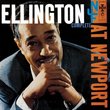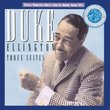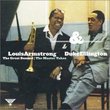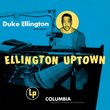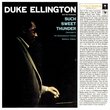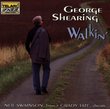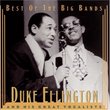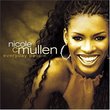| All Artists: Duke Ellington Title: Blues in Orbit (Reis) Members Wishing: 1 Total Copies: 0 Label: Sbme Special Mkts. Release Date: 2/1/2008 Album Type: Original recording remastered Genres: Jazz, Pop Style: Swing Jazz Number of Discs: 1 SwapaCD Credits: 1 UPC: 886972414225 |
Search - Duke Ellington :: Blues in Orbit (Reis)
 | Duke Ellington Blues in Orbit (Reis) Genres: Jazz, Pop
The atmospheric, floating quality (see title) of the production and the mysterious, airy, and sparse arrangements make this album an overlooked gem in the Ellington catalog. Two of the tracks were cut in 1958 utilizing the... more » |
Larger Image |
CD DetailsSynopsis
Amazon.com The atmospheric, floating quality (see title) of the production and the mysterious, airy, and sparse arrangements make this album an overlooked gem in the Ellington catalog. Two of the tracks were cut in 1958 utilizing the full 15-piece orchestra: the slow-moving blues of the title track, where the leader's eerie piano fills answer the statements of the full band, and "Track 360," a dramatic aural representation of a train wreck. The remainder of the CD (minus one other track) was recorded with slightly smaller configurations at two midnight sessions in December of the following year. Ray Nance (the only trumpet because of band restructuring) and especially Johnny Hodges offer the most rewarding solo contributions of the date, many of which stand alongside their best ever. Hodges's magnificently fragile and seductive alto graces "Brown Penny" and handles both delicate and driving passages with aplomb on Billy Strayhorn's "Smada" (with the composer in the piano chair) while Nance belts out the bridge. The band also revisits earlier classics from the Ellington songbook: Nance shows his violin prowess on "C Jam Blues" before growling through "In a Mellotone"; "Sentimental Lady" is in Hodges's capable caress. --Marc Greilsamer Similar CDs
Similarly Requested CDs
|
CD ReviewsTrue classic! William Devine | Chicago | 08/04/2009 (5 out of 5 stars) "This album is a Classic! i had the 33LP of this but my ex cracked it in half one night after i came home and was playing it "to loud!" for her, it was not Dukes fault she had to wake up in three hours! it was not Jimmy Hamilton's Fault she had a business meeting coming up that day! and it was not Woodman's fault our bedroom was downstairs directly from the listening room! nope in fact if my memory serves me rite my ex got to decorate the house while i got the upstairs to myself, hey good Jazz and Blues such as this LP brought one can not...not do some foot tapping on the hardwood floors above sleeping beauty. the horn sections and passages in this recording are seriously amazing (plus she hated the sound of horn)! the Trumpet's slow charlie brown like ways in Sweet & Pungent drove her bananas! the stand up bass in Blues In Blueprint rattled threw her spine! i ordered the Cd of this recording afterwards and while the sound quality was not up to par as the vinyl it was a bit harder for her to find while i was at work (which she did a week later and destroyed it). i then bought the mp3 album which sounded as good as the cd but then the ex sold my ipod..lucky i have a backup. " Not recommended for listeners who hate the blues. Samuel Chell | Kenosha,, WI United States | 03/10/2010 (5 out of 5 stars) "Sometimes I think the best response to the question posed by one of Duke's compositions, "What Am I Here For?" is simply: "To listen to the music of Duke Ellington." Whenever I pick up another recording by his band--whether a pre-Strayhorn edition dating back to the Cotton Club days or the Strayhorn-Blanton-Webster edition of the band or the Paul Gonsalves band of Duke's last 20 years--I'm lost to virtually all other music. No one represents the entire history of the art form as well as its prehistory (addressed by James Baldwin in "Sonny's Blues") better than Duke; no one achieves a more democratic, ideal balance between compositional brilliance and individual expressiveness; no sound is more heavenly (i.e. in a non-terrestrial orbit) than that of Duke's brass, woodwind section, or simply the solo voice of Johnny Hodges). But this might be considered a noteworthy achievement if for no other reason than the common meeting ground it stakes out--the elemental 12-bar blues form--for the average listener and the genius of Ellington. Ellingtonian blues music makes everything else seem shallow, evanescent, unworthy of a listener's precious time--in that sense it surpasses the mundane and reaches the universal regions of the human spirit. There's reassuring recognition and familiarity on each track along with continual surprise--even on the alternate takes. The program begins with a blues sermon preached by a tenor player who sounds more like Ben Webster than Paul Gonsalves. The program notes suggest it's the tenor of Jimmy Hamilton, who sounds superb on the instrument on this date. He's answered by perhaps as tight a trio of trombone plungers as has ever been assembled, comprising Booty Wood, the incredible Britt Woodman, and Quentin Jackson (modernist Matthew Gee rounds out the section, which was without Lawrence Brown on this occasion). And not least of all there's Duke's piano--an assimilation of the styles that had preceded him, from James P., Fatha, Fats, and Willie the Lion, to those--Thelonious Monk, Horace Silver--who absorbed some of the sparks created by Duke's ever evocative, seminal playing, which I now realize was as responsible for what happened at Newport in 1956 during those 28 immortal choruses as was Paul Gonsalves himself. This one is going for prices that make it possible to pick up 5-6 for the price of one and to give them to anyone who will listen. Or use the spare change to grab up "Such Sweet Thunder " (almost as good as reading Shakespeare), "Ellington Uptown" (the best version of "A Train" ever recorded plus Louis Bellson playing his own "Skin Deep") and "Three Suites" (the biggest bargain in recorded music, with Duke's brilliant revision of Tchaikovsky merely one of three masterworks)." BIG BAND BLUES COMPUTERJAZZMAN | Cliffside Park, New Jersey United States | 10/17/2007 (5 out of 5 stars) "THE SONGS RECORDED FOR THIS ALBUM WERE MADE IN 1958 & 1959. DUKE ELLINGTON IS A MASTER AT THE TOP OF HIS GAME FOR THIS RELEASE. GREAT ARRANGMENTS, RECORDING QUALITY, AND MUSICIANSHIP, PARTICULARLY ELLINGTON BAND MAINSTAYS RAY NANCE (TRUMPET) AND JOHNNY HODGES(SAX)AND, OF COURSE, THE DUKE HIMSELF. NO NEED TO GO INTO A SONG BY SONG ANALYSIS, 'CAUSE THEY ALL STAND OUT. NOT A BAD CUT ON THE ALBUM. PICK UP ANY OF THE ALBUMS BY DUKE ELLINGTON RECORDED IN THE 1950'S AND YOU WILL NOT BE DISAPPOINTED."
|

 Track Listings (19) - Disc #1
Track Listings (19) - Disc #1